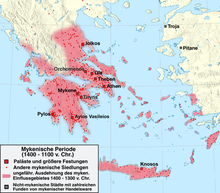Mycenean civilisation
 |
|
| Period | Bronze Age |
|---|---|
| Dates | c. 1600 – c. 1100 BC |
| Preceded by | Minoan civilization |
| Followed by | Greek Dark Ages |
Mycenaean Greece (or Mycenaean civilization) was the last phase of the Bronze Age in Ancient Greece (c. 1600–1100 BC). It represents the first advanced civilization in mainland Greece, with its palatial states, urban organization, works of art and writing system. Among the centers of power that emerged, the most notable were those of Pylos, Tiryns, Midea in the Peloponnese, Orchomenos, Thebes, Athens in Central Greece and Iolcos in Thessaly. The most prominent site was Mycenae, in Argolid, to which the culture of this era owes its name. Mycenaean and Mycenaean-influenced settlements also appeared in Epirus,Macedonia, on islands in the Aegean Sea, on the coast of Asia Minor, the Levant,Cyprus and Italy.
The Mycenaean Greeks introduced several innovations in the fields of engineering, architecture and military infrastructure, while trade over vast areas of the Mediterranean was essential for the Mycenaean economy. Their syllabic script, the Linear B, offers the first written records of the Greek language and their religion already included several deities that can also be found in the Olympic Pantheon. Mycenaean Greece was dominated by a warrior elite society and consisted of a network of palace states that developed rigid hierarchical, political, social and economic systems. At the head of this society was the king, known as wanax.
...
Wikipedia
